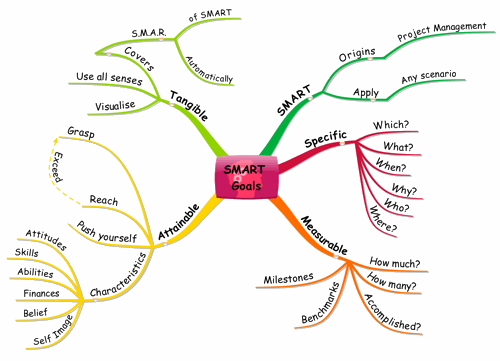Mind Map SMART Goals to plan your success...

Subscribe to Using Mind Maps
Get Access to the Best Mind Mapping Tips, Tools, Techniques Resources and Opinions.
SMART
Even though the SMART acronym for goal setting originated in the Project Management discipline, it has become more widely used and can be applied to any goal setting scenario.
You can Mind Map SMART goals at work to plan your career, get tasks done or even create a development plan.
Let's first get a handle on what the acronym SMART represents.
The Acronym
Before going further, it will be wise for you to grasp the acronym fully. It is simple, so take a few minutes to learn and memorise it.
- Specific
- Measurable
- Attainable
- Realistic
- Tangible
You are now ready to explore the acronym before you start to Mind Map SMART Goals.
Specific
Specific Goals are simply goals that are not vague. The better you describe the goals and the more specific you make it, the better. The following key questions often naturally make the goals specific:
- WHICH: Identify requirements and constraints
- WHEN: Establish a time frame
- WHY: Specific reasons, purpose, or benefits in accomplishing the goal
- WHAT: What do I want to accomplish?
- WHERE: Identify a location
- WHO: Who is involved?
The first thing you have to do is define your goals and choose one to work through. (Which?)
Once you have gone through these questions around your goal, you will know what you want to achieve, why you want to achieve it, by when you want to achieve it who will be involved in helping you achieve your goal.
One of the methods that I normally recommend to record your goals is quite a simple one and especially useful if you don't use Mind Maps to organise your life.
- Get a diary
- Go to the front of the Diary and write in the Goals and the dates by which you want to achieve them
- Turn to the appropriate page in you diary and write down the goal there as well
- Look at your goals daily, or at least weekly if you can't manage daily
Measurable
This is based on the management cliche, what you can't measure, you can't manage. Define ways YOU think you can measure your progress. It is important that YOU set the measurement criteria. Other people can give input, but you have to define your own standards by which you are going to measure whether you are successful or not. The responsibility is yours.
Some questions you can ask:
- How much?
- How many?
- How will I know when it is accomplished?
- What are the Benchmarks against which I can measure it?
- Are there Milestones that I can set to ensure I am on track?
Attainable
The attainable key word pertains largely to your own growth and development. If your goals are defined well, which the SMART acronym enables you to do, you will find that you will grow as an individual on your path to achieving your goals.
Some important characteristics that determine whether you see the goals as attainable:
- Self-image and belief
- Financial capability
- Abilities
- Skills
- Attitudes
The statement by Robert Browning: 'Ah, but a man's reach should exceed his grasp', comes to mind, which has commonly been associated with setting goals a bit higher than you can attain comfortably.
The following can help you to understand the reach/grasp meaning and help to visualise it quite nicely:
Do the following exercise (or picture it):
- Stand an arm's length away from an object, keeping your arm straight out in front of you.
- Ensure that the tips of your fingers are touching the object. That is your reach.
- Now close you hands into a fist, without moving your arm. That is your grasp.
- Does your hand still reach the object?
Realistic
When thinking realistic, two words come to mind: willing and able.
Both are needed to ensure that realistic goals that are attainable are defined. Only you will know whether you are willing to put in the work to achieve the goal or not. Your willingness to work, will determine your ability to achieve the goal.
Tangible
I prefer tangible to time bound for this letter of the acronym, as time can be covered in the specific and measurable parts. It can even be covered in the attainable and realistic components, as setting an realistic/unrealistic timeframe has a huge influence on whether the goal is attainable or realistic.
Tangible involves the senses, especially the visualisation component. Many people involve all five senses in the visualisation process. If you can see, feel, touch, taste and hear it, you can achieve it. By making it tangible, you automatically cover the specific, measurable, attainable and realistic components of your goals.
Make sure you read and re-read this article, as goal setting is so important for success at work. Mind Map SMART Goals to ensure that you put plans in place to have the best chance at success possible.

Free SMART Goals Interactive Mind Map
Download the free XMind Mind Map below and use it to define your own goals. Add images, thoughts, ideas and of course, your own goals.
Return from Mind Maps SMART Goals to Using Mind Maps at Work
Return from Mind Map SMART Goals to Using Mind Maps home page



